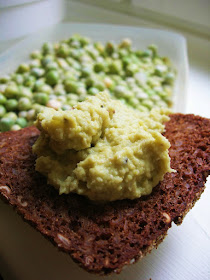 Continuing with the theme "simple cooking", today I made crusted tofu with potatoes and basic brown sauce. Too bad I forgot the lingonberry jam from the photo.
Continuing with the theme "simple cooking", today I made crusted tofu with potatoes and basic brown sauce. Too bad I forgot the lingonberry jam from the photo.- about 350 g firm tofu (smoked or marinated in tar liqueur)
- 2 dl oat or soy milk
- 3 tbsp potato flour
- bread crumbs
- nutritional yeast
- small seeds for decorative purpose, for example hemp seeds, oat grains or pine kernels
- dry spices, for example onion powder, paprika powder, curry, black pepper and chili powder
- 1.5 dl tar liqueur (my new favourite seasoning)
- rape oil
Pour a good pond of oil in a large frying pan and turn on the stove. Cut the tofu in 16 flat pieces. (For me, triangle shapes look the nicest.) Dissolve the flour in the milk. Mix all the other dry ingredients in a bowl. Dip the tofu pieces in the milk, roll them in the crust mixture and put them on the pan. When you've fried the triangles from both sides, pour the tar liqueur on them and let most of the liquid vaporize before serving.
And by the way, the remainings of the crusting materials can be used to make a sauce.
Nutritional values / 1 piece / about 30 g (This doesn't include the liqueur cause I can't find any information about it's contents besides the alcohol percent)
Energy 71.4 kcal
Fat 3.9 g
Protein 4.5 g
Carbohydrates 4.9 g
Fiber 0.5 g




